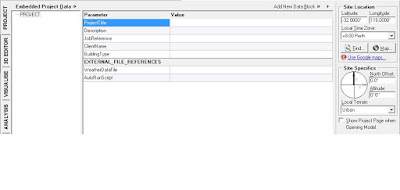My first post on this topic is in regard to how projects get setup and defined by these two applications. You gotta start somewhere, so let's start with how these two applications approach this area.
Ecotect - after starting the program, the user selects a project tab. From this tab, they can input project information, including address, site location, terrain, etc. A nice touch is the incorporation of Google Maps (which also happens to be a site location option in Revit 2011):
 Once the project information has been input, the user goes to the data manager to set up project specifics - then the building conditions tool, then the model settings tool. While some of these settings can be predefined, having them scattered throughout several pulldowns and windows can make winding your way through these settings, and making sure everything is set as needed, a bit difficult.
Once the project information has been input, the user goes to the data manager to set up project specifics - then the building conditions tool, then the model settings tool. While some of these settings can be predefined, having them scattered throughout several pulldowns and windows can make winding your way through these settings, and making sure everything is set as needed, a bit difficult.For IES VE 6.0.6, the project is started by selecting New Project, then choosing a template that sets up a wide variety of project specific settings:
The templates can save the user a tremendous amount of setup time, covering building regulations, room conditions, the air system, internal gains and exchanges, as well as default analysis type data. The fact that the user is pointed to these specific settings at the very beginning, instead of having to dig through the program to find these setups, gives the startup leg to IES.
Next up - importing geometry and data into the project...
